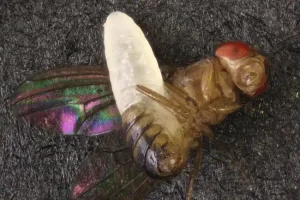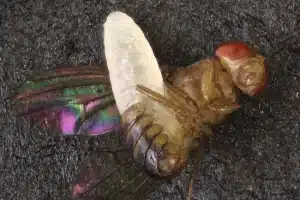Have you heard the new buzz around town? An assistant professor at Mississippi State University has led to the discovery of a frightening new parasitic wasp species with peculiar origins.
In an article penned in the world’s leading science journal, Nature, Assistant Professor Matthew Ballinger explains how his team’s efforts paved the way for researchers to discover a species of wasps that use fruit flies to give birth.
The wasps, coined Syntretus perlmani, are found to use their stingers to lay eggs in a fruit fly’s abdomen. The wasp embryo then hatches inside the living fly and bursts out of the fly’s belly looking like a mutant alien creature around 18 days later. To make matters even scarier, the host fly typically remains alive long enough to endure the early stages of the brutality before ultimately passing away.

“It will effectively emerge out of the side of the fly,” Logan Moore, Ballinger’s Ph.D. student at Mississippi State who helped spearhead the research, told Live Science. “And just to add an additional layer of horror, the fly will normally remain alive for several hours after that.”
Once out of the fly, the baby wasps remain in a gel-like protective structure for just over three weeks and then emerge as fully-grown adult wasps.
Moore, the Nature article’s lead author, began the research in March 2023 by collecting infected fruit flies from his backyard in Starkville. The researchers were screening the fruit flies for parasitic worms. A turn in the research was taken when the team first noticed a peculiar spiky-tailed wasp larva.
While researchers have known for quite some time that parasitoid wasps attack flies in the early stages of life, the discovery of the species bombarding adult fruit flies in this manner was a foreign concept until recently, even though Ballinger’s team did not initially believe their eyes when they witnessed a wasp exiting a fly’s abdomen.
“All known parasitoid wasps of flies attack and develop inside immature life stages,” Ballinger said. “And despite 200 years of research on parasitoid wasps of Drosophila and other flies, we have never come across a species that attacks the adult stage, until now.”
Hidden in plain sight? Scientists frequently assess fruit flies for genetic research as a large share of their genes are linked to human diseases. However, Moore says the discovery likely took so long because nobody was expecting such a phenomenon to be occurring.
Though the idea of a wasp placing its offspring into a fruit fly just for the offspring to catapult out of the fly’s insides may seem horrifying, a silver lining is that Syntretus perlmani could be beneficial in reducing the population of an insect species that is notorious for being a nuisance.
“Almost everybody in the world has had some sort of interaction with this fly, usually not in a good context,” Moore said. “They’re annoying little pests that fly around your fruit.”
The post ‘Horror wasp’ is the new buzz as Mississippi scientists discover frightening insect species appeared first on SuperTalk Mississippi.



